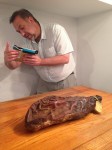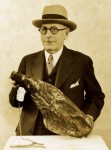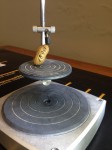 A 112-year-old ham and 125-year old peanut in the collection of the the Isle of Wight Museum in Smithfield, Virginia, have been 3D scanned by Virginia Commonwealth University anthropology professor Dr. Bernard Means. Means specializes in scanning archaeological artifacts and recreating them with 3D printing for use in the classroom and to give the public something they can touch and explore while learning about the ancient objects. The result is the Virtual Curation Laboratory, a collection of more than 600 3D printed artifacts scanned from originals at Jamestown Rediscovery, Mount Vernon, Montpelier, the State Museum of Pennsylvania, the Virginia Museum of Natural History and many other institutions. Its primary focus is on Native American artifacts, but when the Isle of Wight Museum asked Dr. Means to scan their ham and peanut, he was glad to oblige.
A 112-year-old ham and 125-year old peanut in the collection of the the Isle of Wight Museum in Smithfield, Virginia, have been 3D scanned by Virginia Commonwealth University anthropology professor Dr. Bernard Means. Means specializes in scanning archaeological artifacts and recreating them with 3D printing for use in the classroom and to give the public something they can touch and explore while learning about the ancient objects. The result is the Virtual Curation Laboratory, a collection of more than 600 3D printed artifacts scanned from originals at Jamestown Rediscovery, Mount Vernon, Montpelier, the State Museum of Pennsylvania, the Virginia Museum of Natural History and many other institutions. Its primary focus is on Native American artifacts, but when the Isle of Wight Museum asked Dr. Means to scan their ham and peanut, he was glad to oblige.
“The ham and the peanut are clearly important to the people of Isle of Wight County, and Virginia as well, and the lab is pleased to help them tell the story,” Means said. “But, I can also use the ham scan and peanut scan to teach my students at VCU.”
In the spring semester, Means and his students will be working on a series of exhibits, and the ham and peanut scans will likely be featured among a larger presentation of the human use of animals and plants. Some of these items, he said, will go on display at the VCU Globe building in the spring.
Officials with the Isle of Wight County Museum may also talk with Means’ students remotely about their museum and why the ham and peanut are important cultural artifacts.
The ham is the crown jewel in the Isle of Wight Museum collection and has achieved national fame in the years since it was first cured and hung from a rafter in one of P.D. Gwaltney Jr.’s packing houses in 1902. P.D. Gwaltney, Jr., founded the pork processing company with his father P.D. Gwaltney, Sr., in 1880 and soon Gwaltney hams became a household name. Junior was instrumental in the passage of the 1926 act of the Virginia General Assembly which defined Smithfield hams as a product raised only in specific parts of Virginia and North Carolina and makes imposter hams liable to fines.
 That one 1902 ham was overlooked as the company expanded and became increasingly successful. When it was finally rediscovered in 1922, P.D. Gwaltney, Jr., adopted it as a company mascot and pet. By 1924 Gwaltney had it in an iron safe which he opened daily to show off his prize superannuated ham to visitors and guests. He then had a brass collar inscribed “Gwaltney’s Pet Ham” and a leash made for the ham and took it on the road to conventions and county fairs an example of how effective and safe the Gwaltney curing process was. He insured it against fire and theft for $1,000, upping it to $5,000 in 1932. The ham has been featured in Ripley’s “Believe It or Not” cartoon three times — in 1929, 1932 and 2003 — and gets yearly birthday parties where “Hammy Birthday” is sung by an adoring populace. The museum also has a webcam appropriately named HamCam pointed at Gwaltney’s pet for those who can’t get their ancient ham fix in person.
That one 1902 ham was overlooked as the company expanded and became increasingly successful. When it was finally rediscovered in 1922, P.D. Gwaltney, Jr., adopted it as a company mascot and pet. By 1924 Gwaltney had it in an iron safe which he opened daily to show off his prize superannuated ham to visitors and guests. He then had a brass collar inscribed “Gwaltney’s Pet Ham” and a leash made for the ham and took it on the road to conventions and county fairs an example of how effective and safe the Gwaltney curing process was. He insured it against fire and theft for $1,000, upping it to $5,000 in 1932. The ham has been featured in Ripley’s “Believe It or Not” cartoon three times — in 1929, 1932 and 2003 — and gets yearly birthday parties where “Hammy Birthday” is sung by an adoring populace. The museum also has a webcam appropriately named HamCam pointed at Gwaltney’s pet for those who can’t get their ancient ham fix in person.
The Isle of Wight Museum’s greatest star is billed as the world’s oldest cured ham (there’s a Chicago ham 10 years older than the Gwaltney ham hanging in a butcher’s shop window in Oxford, England) and is reputedly still edible. Edible and delectable are not synonymous, obviously. The fat in dry cured meat oxidizes before its tenth birthday taking much of the flavor with it. Then as it diffuses throughout the ham, it gives it a rancid odor and taste. Eventually it gets rock hard and darkens. The oldest commercially available hams are aged for eight years.
Still, theoretically if you discarded enough of the outer layers, there would be a ham nugget in there that could be ingested by humans without killing them, ie, it’s edible. Dr. Means noted that the ham has “a powerful scent that I cannot describe,” which I’m guessing was more on the powerful stench side of the scale than the powerful delicious side.
 As for the peanut, it can’t compete with the ham for fame, but it’s older and is tied both to the Smithfield ham tradition and to the Gwaltney family’s personal history. Before getting into the pork business, P.D. Gwaltney, Sr., had been in the peanut business in Tidewater, Virginia. He built the first industrial peanut cleaning plants and was known as the Peanut King before Amedeo Obici took the crown with his Planters Peanut Company in the early 20th century. Processing peanuts and processing hams were connected businesses at the time. In fact, when the 1926 act was passed, one of the definitions of a Smithfield ham was that the hogs were peanut-fed. This requirement was eliminated in 1966.
As for the peanut, it can’t compete with the ham for fame, but it’s older and is tied both to the Smithfield ham tradition and to the Gwaltney family’s personal history. Before getting into the pork business, P.D. Gwaltney, Sr., had been in the peanut business in Tidewater, Virginia. He built the first industrial peanut cleaning plants and was known as the Peanut King before Amedeo Obici took the crown with his Planters Peanut Company in the early 20th century. Processing peanuts and processing hams were connected businesses at the time. In fact, when the 1926 act was passed, one of the definitions of a Smithfield ham was that the hogs were peanut-fed. This requirement was eliminated in 1966.
The Isle of Wight Museum plans to add the 3D scans to its website, giving viewers a different view of the famed pork product than what they can see through the HamCam. It may even use the scans to create a 3D printed ham for visitors to interact with since the original is kept under glass for preservation purposes.